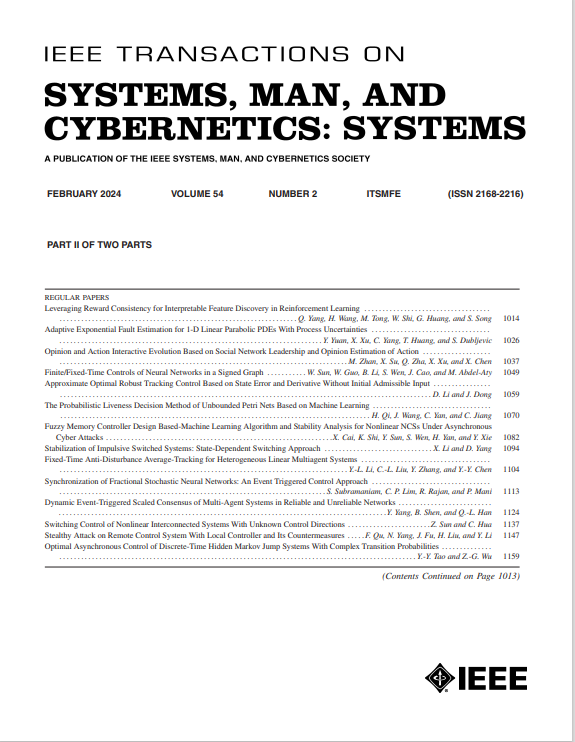Collaborative Control of Human–Machine Game in Lateral and Longitudinal Dimensions Considering Dynamic Allocation of Driving Authority
IF 8.6
1区 计算机科学
Q1 AUTOMATION & CONTROL SYSTEMS
IEEE Transactions on Systems Man Cybernetics-Systems
Pub Date : 2025-03-26
DOI:10.1109/TSMC.2025.3549424
引用次数: 0
Abstract
In the process of human-machine collaborative driving, it is crucial to ensure that the driver and the machine operate the vehicle in a safe, stable, and efficient manner. However, most of the current studies focus on the lateral shared control under the condition of constant longitudinal speed, without considering the influence of longitudinal speed change on lateral control. Therefore, this article proposes a collaborative control framework of human-machine game in lateral and longitudinal dimensions considering dynamic allocation of driving authority to improve the collaborative performance of co-driving. First, a human-machine collaborative driving system model that adapts to the characteristics of co-driving mode is built as the basis of the shared control scheme. Then, the unconscious competitive relationship of human-machine is described as the game interaction relationship, with optimal control strategies for both sides being deduced theoretically at the game equilibrium. Additionally, a dynamic adjustment strategy of driving authority considering the longitudinal speed is established based on the assessment of lateral and longitudinal risks. Finally, the driver-in-the-loop test and co-simulation results show that the proposed control strategy has achieved good performance in terms of path tracking, driver’s driving burden, and vehicle stability.考虑驾驶权限动态分配的横向和纵向人机博弈协同控制
在人机协同驾驶过程中,确保驾驶员和机器安全、稳定、高效地操作车辆是至关重要的。然而,目前的研究大多集中在恒定纵向速度条件下的横向共享控制,没有考虑纵向速度变化对横向控制的影响。为此,本文从横向和纵向两个维度提出了考虑驾驶权限动态分配的人机博弈协同控制框架,以提高协同驾驶的协同性能。首先,建立适应共驾驶模式特点的人机协同驾驶系统模型,作为共享控制方案的基础;然后,将人机无意识竞争关系描述为博弈交互关系,从理论上推导出博弈平衡点下双方的最优控制策略。在横向风险和纵向风险评估的基础上,建立了考虑纵向速度的驾驶权限动态调整策略。最后,驾驶员在环试验和联合仿真结果表明,所提出的控制策略在路径跟踪、驾驶员驾驶负担和车辆稳定性方面取得了良好的性能。
本文章由计算机程序翻译,如有差异,请以英文原文为准。
求助全文
约1分钟内获得全文
求助全文
来源期刊

IEEE Transactions on Systems Man Cybernetics-Systems
AUTOMATION & CONTROL SYSTEMS-COMPUTER SCIENCE, CYBERNETICS
CiteScore
18.50
自引率
11.50%
发文量
812
审稿时长
6 months
期刊介绍:
The IEEE Transactions on Systems, Man, and Cybernetics: Systems encompasses the fields of systems engineering, covering issue formulation, analysis, and modeling throughout the systems engineering lifecycle phases. It addresses decision-making, issue interpretation, systems management, processes, and various methods such as optimization, modeling, and simulation in the development and deployment of large systems.
 求助内容:
求助内容: 应助结果提醒方式:
应助结果提醒方式:


